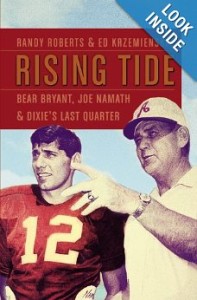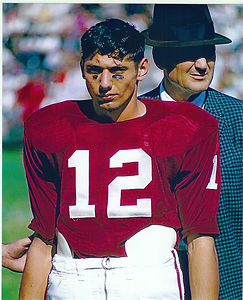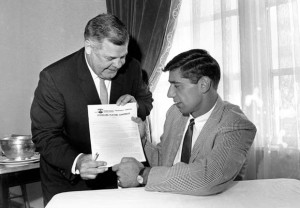Book Review: Rising Tide Provides Glimpse Into Alabama Football During Era Of Bryant and Namath

The new book looks at the sometimes dicey relationship between two Alabama legends Bear Bryant and Joe Namath.
The new book by Randy Roberts and Ed Krzemienski, Rising Tide : Bear Bryant, Joe Namath and Dixie’s Last Quarter, is dedicated to, among others, “all of the … passionate fans of the Crimson Tide, the most successful college football team in history.” It was not, however, written by fans.
In interest of full disclosure, I was born in 1965, just a few months after the last events of this book, and have been a fan of the Crimson Tide since 1972. I graduated from the Capstone in 1991, just a year shy of being able to experience the joys of 1992 for myself. I worked in the sports information office with Coach Gene Stallings, knew Dude Hennessey, Charley Thornton and Clem Gryska among others cited in the book.
If you’ve ever wondered why, when discussing the pantheon of greats from Tide history, Joe Namath doesn’t seem to get mentioned quite as often as Harry Gilmer, Don Hutson, Vaughn Mancha, Dixie Howell, Pat Trammel, Lee Roy Jordan, Johnny Musso, Kenny Stabler, Bob Baumhauer, Woody Lowe Ozzie Newsome or any of the newer stars, despite the fact that Bryant often called him the “greatest athlete I ever coached,” this book might help you understand it. Ever the outsider, Namath starred for the University of Alabama, but he never really was “part” of it. To paraphrase Chris Peterson, he wasn’t O.K.P. (our kinda player).
If you really are a fan of the Tide and have even a little sense of the history (and I don’t think you get to call yourself a ‘fan’ if you don’t), then there really is not a ton of new material here from a program perspective. There is, however, a great deal of background information about Namath, culled from interviews with family, friends and the man himself. That material alone makes the book worth the effort.
The tome itself is a meandering read, skipping back and forth between the two main men. There is much of the book that deals solely with Bryant, another large chunk that tackles Namath alone and yet a third hunk deals with the race relations of the era. Though it is somewhat chronological, following events from the recruitment of Joe Namath as a prep star through his signing with the Jets after the 1965 Orange Bowl, it tends to jump back and forth along that timeline, with further divergences thrown in for good measure. The prose, too, can be a little choppy in places, though not so disastrously as to make it unreadable.
Fans of the program should prepare themselves for an honest look at the culture of college football at the time. Tales of shenanigans that would surely land a player or program today on NCAA investigation, if not probation, are told with very little to soften them. The knowledgeable will cringe to read them.

The lasting legacies for both Bear Bryant and Joe Namath were shaped in the years after they shared the sideline in Tuscaloosa.
Again, though it claims to be “for the fans,” the book spends quite a bit of time on the history of the program (and of college football in general) from its beginnings. Truly knowledgeable fans will not find many surprises, but it is not too pedantic.
Despite the fact that most fans my age probably had grandparents adjacent to, if not mired deeply in, the race problems of the 1950s and 1960s, the section on the race relations of the region in the era is an uncomfortable read, although perhaps that is all for the best. Those who forget history are doomed to repeat it and all that.
Two of the very interesting portions about Bryant are the discussions of how he became the coach at Alabama and the methods that he used to prepare his teams. Perhaps it is just the current team’s success and spotlight, but I could not help but notice similarities between Bryant and current coach Nick Saban.
Bryant, serving as the coach at Texas A&M at the time was rumored to be heading for Tuscaloosa long before he actually accepted the job and he was unhappy with the media coverage of the rumors. When he was advised by a reporter friend from the Houston Post to simply issue a flat denial, Bryant replied “No, I wouldn’t want to say that because I might do it.” (pg. 24) That, of course, contrasts with the Saban’s statements while leading the Miami Dolphins that he “would not be the next head coach at Alabama.” (ESPN)
The preparations, the legendary brutal work outs and conditioning drills, which Bryant used to mold champions, sound an awful lot like Saban’s “Process” which has won three of the last four national titles. Bryant’s “Be Good or Be Gone” mantra, to control the little things that actually in the end decide games and championships (fundamentals, conditioning, desire) seem to be the same things that “The Process” seeks to instill.
For Namath, the book goes out of its way to clarify that Namath did not really fit in at Alabama; that he was a man apart. One of the most famous stories about Namath and Bryant involve the former’s invitation to the coach’s famous tower, making him the only player, perhaps the only person, to ever ascend to those heights besides Bryant. Therein lays the basis for the fan base’s apathy toward Namath, despite the “greatness” he actually produced very little in his three seasons as a starter. He did help lead the team to the national title as a senior, despite a loss in the Orange Bowl to Texas when Namath failed to score after audibling his own number on fourth down from the one. He was suspended from the team (for violation of team rules) for the Iron Bowl and Sugar Bowl his junior season, both games that the Tide won without him. His best season came in his first, and he got progressively less effective each year. His famous knee injury, which certainly limited his effectiveness, did not occur until the fourth game of his senior season.
The whole section on race relations seems a tad contrived. Certainly, it was the hot topic of the era. Bryant certainly advocated integrating the football team long before it actually happened and Namath had played with and against players of other races all the way up to his college career and then again afterward. But the book does little to tie the two main characters to the issue, rather just using it as a backdrop to the football-related events. For example, on the day of George Wallace’s “stand in the school house door,” Bryant was not in town and, though the book mentions that Namath was at least in the vicinity, it does not reveal any of his thoughts on the confrontation. (pg. 234).
The epilogue deals with Namath’s wooing by professional football and his eventually signing with the New York Jets. Nearly everything about it would be considered a violation today (Namath had an “agent” prior to the bowl game and accepted many benefits prior to completing his Alabama career). But the rules were much less codified at the time and Namath and the program were scrupulous about following the letter of the law at the time. Still the whole thing is unseemly.
It is tough to whole-heartedly recommend the book. It seems to struggle to find an audience. At times it gets very specific and technically based. At other times seems very simplistic in its presentation. It claims to the written for Tide “fans” but paints a pretty poor picture of the program and the state; a picture that is sure to anger those same fans. About the best I can say about it, the book for me finally answers the question of why Joe Namath is never listed among the top 10 stars of Alabama football. If you have ever wondered that yourself, here’s the answer.

Bryant and Namath was an awesome footballers! They are my heroes.
Warriors college NBA jerseys cheap
wholesale Flyers cheap jerseys,we promise to offer the best jerseys for customers.